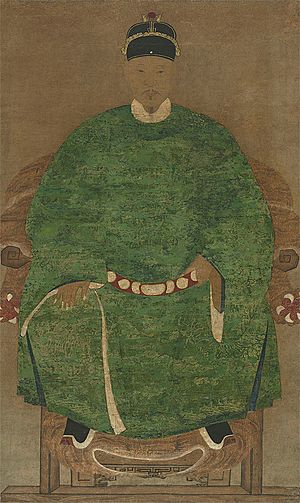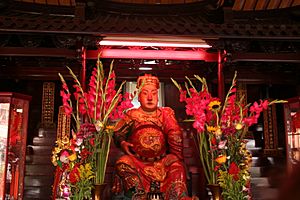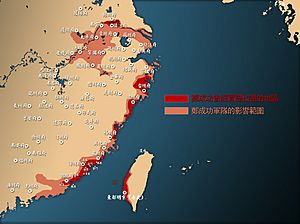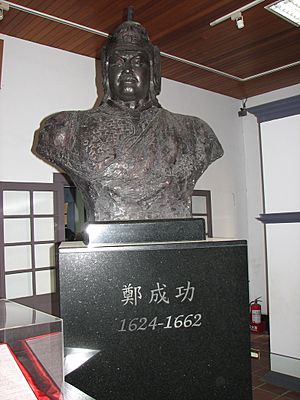Koxinga facts for kids
Quick facts for kids Zheng Chenggong鄭成功 |
|||||
|---|---|---|---|---|---|
| 1. Count of Zhongxiao 2. Marquis of Weiyuan 3. Duke of Zhang 4. Prince of Yanping |
|||||

The mid-17th century painting The Portrait of Koxinga
|
|||||
| Ruler of the Kingdom of Tungning | |||||
| Reign | 14 June 1661 – 23 June 1662 | ||||
| Successor | Zheng Xi | ||||
| Born | Zheng Sen 27 August 1624 Hirado, Hizen Province, Japan |
||||
| Died | 23 June 1662 (aged 37) Anping, Kingdom of Tungning |
||||
| Spouse | Dong You, Princess Wu of Chao | ||||
| Issue | Zheng Jing and nine other sons, four daughters |
||||
|
|||||
| House | Koxinga | ||||
| Dynasty | Tungning | ||||
| Father | Zheng Zhilong | ||||
| Mother | Tagawa Matsu | ||||
| Koxinga | |||||||||||||||||||||
|---|---|---|---|---|---|---|---|---|---|---|---|---|---|---|---|---|---|---|---|---|---|
| Traditional Chinese | 國姓爺 | ||||||||||||||||||||
| Hokkien POJ | Kok-sèng-iâ Kok-sìⁿ-iâ |
||||||||||||||||||||
| Literal meaning | Lord of the Imperial Surname | ||||||||||||||||||||
|
|||||||||||||||||||||
| Zheng Chenggong | |||||||||||||||||||||
| Traditional Chinese | 鄭成功 | ||||||||||||||||||||
| Hokkien POJ | Tīⁿ Sêng-kong | ||||||||||||||||||||
|
|||||||||||||||||||||
| Zheng Sen | |||||||||||||||||||||
| Traditional Chinese | 鄭森 | ||||||||||||||||||||
| Hokkien POJ | Tīⁿ Sim | ||||||||||||||||||||
|
|||||||||||||||||||||
Zheng Chenggong (born August 27, 1624 – died June 23, 1662), also known as Koxinga, was a famous general from China. He lived during a time when the Ming dynasty was falling and the Qing dynasty was taking over. Koxinga was loyal to the Ming dynasty and fought against the Qing armies along China's southeastern coast.
In 1661, Koxinga led his forces to Taiwan. He defeated the Dutch who had set up trading posts there. After his victory, he created his own ruling family, the House of Koxinga. This family ruled part of Taiwan as the Kingdom of Tungning from 1661 to 1683.
Contents
Biography of Koxinga
Early Life and Education
Zheng Chenggong was born in 1624 in Hirado, Japan. His father, Zheng Zhilong, was a Chinese merchant, and his mother, Tagawa Matsu, was Japanese. He was known by his Japanese name, Fukumatsu, until he was seven years old. Then, he moved to Fujian province in China.
In 1638, Zheng passed an important test called the imperial examination. This meant he was a very smart student. In 1644, he studied at the Imperial University, where he met a famous scholar named Qian Qianyi.
In 1644, the capital city of Beijing fell to rebels. The Ming emperor died. Soon after, armies from Manchuria (who later formed the Qing dynasty) took over Beijing. The remaining Ming forces tried to continue their rule in southern China.
Becoming a Ming General
In 1645, a new Ming emperor, the Longwu Emperor, was put on the throne with help from Zheng Zhilong's family. The emperor set up his court in Fuzhou, a city controlled by the Zhengs. The Longwu Emperor gave Zheng Sen, Koxinga's original name, a new name: Chenggong, which means "success." He also gave him the special title of Koxinga, meaning "Lord of the Imperial Surname." This showed Koxinga's close connection to the Ming royal family.
In 1646, Koxinga led Ming armies against the Manchu invaders for the first time. However, his father, Zheng Zhilong, decided to surrender to the Qing forces. This left Koxinga and his uncles in charge of the family's military power. Koxinga quickly gathered many followers and began launching attacks on Qing-controlled areas in Fujian.
Fighting the Qing Dynasty
By 1650, Koxinga had become the strong leader of the Zheng family. He promised his loyalty to the Yongli Emperor, another Ming emperor who was trying to escape the Manchus. Koxinga decided to focus on protecting his own area on the southeastern coast of China.
Koxinga won several battles in 1651 and 1652, which worried the Qing government. His father, Zheng Zhilong, who was now with the Qing, tried to convince Koxinga to make peace. But Koxinga refused. The Qing then sent a large army to attack Koxinga's territory.
In 1656, the Qing armies attacked Kinmen, an island Koxinga used to train his soldiers. A big storm helped Koxinga's forces win, and the Qing lost most of their ships. This victory allowed Koxinga to plan a major attack on Nanjing, a very important city held by the Qing.
Koxinga's attack on Nanjing began on August 24. It lasted almost three weeks. Even though Koxinga's forces were strong, they couldn't completely surround the city. This allowed Nanjing to get supplies and even more soldiers. Koxinga's forces were eventually defeated and had to retreat to their ships.
Taking Control of Taiwan
In 1661, Koxinga led his troops to Taiwan to attack the Dutch colonists. He told the Dutch that Taiwan had always belonged to China and that they should leave.
Many local tribes in Taiwan, who had previously worked with the Dutch, switched sides and joined Koxinga's Chinese forces. They helped Koxinga by capturing Dutch people and destroying their schools. On February 1, 1662, the Dutch governor of Taiwan surrendered to Koxinga. This ended 38 years of Dutch rule on the island.
After taking Taiwan, Koxinga focused on making it a strong military base. He wanted to use Taiwan to launch more attacks and bring back the Ming dynasty. He also taught the local people new farming methods and gave them tools and oxen.
Plans for the Philippines
In 1662, Koxinga's forces also raided some towns in the Philippines. He sent a messenger to Manila, demanding that the Spanish rulers there pay him tribute. He threatened to kick the Spanish out if they didn't agree. The Spanish refused and prepared for a fight, but Koxinga died suddenly, so the invasion never happened.
Koxinga's threat was so serious that it made the Spanish move their soldiers from other areas, like the Maluku Islands, back to Manila to protect the city.
Koxinga's Death
Koxinga died in June 1662 from malaria. He was only 37 years old. Some people say he died in a fit of anger because his officers wouldn't follow his order to execute his own son, Zheng Jing. However, Koxinga later agreed to let his son Zheng Jing take over as the ruler of the Kingdom of Tungning.
Koxinga's Family Life
Koxinga's life was full of challenges, including family tensions. His title, Koxinga, showed his strong loyalty to the Ming dynasty. He saw himself as a loyal supporter of the Ming emperors, even after they lost power.
Koxinga's father, Zheng Zhilong, left his Japanese wife (Koxinga's mother) soon after Koxinga was born. Koxinga was seven when he finally joined his father in China. His father seemed to recognize Koxinga's talents and encouraged him to study. However, Zheng Zhilong later surrendered to the Qing dynasty, which was very different from Koxinga's continued loyalty to the Ming.
Koxinga's relationship with his mother is often described as very loving. However, they spent very little time together. She only joined him in China around 1645 and was killed by Qing forces a year later.
Koxinga's descendants live in both mainland China and Taiwan, and his brother's descendants live in Japan. Some of his descendants in China fought against the Japanese during the Second Sino-Japanese War.
Koxinga's Children
Koxinga had several children:
- Zheng Jing (1642–1681), his first son, who became the next Prince of Yanping.
- Nine other sons.
- Four daughters.
Koxinga's Personality
Koxinga was known for having a strong temper and could be very strict. Some people thought this was because of his Japanese upbringing and samurai training. A missionary who knew Koxinga said he had "feigned and hearty laughter" when he was angry.
Koxinga's Legacy Today
Worship and Recognition
Koxinga is highly respected in coastal China, especially in Fujian, and by Chinese people living in Southeast Asia and Taiwan. In Taiwan, there is a temple dedicated to Koxinga and his mother in Tainan City. A famous university in Tainan, National Cheng Kung University, is also named after him.
Koxinga in Modern Politics
Koxinga is seen as a hero in China, Taiwan, and Japan, but people have different ideas about his reasons and loyalties.
- Japan sees him as a native son because of his Japanese mother.
- The People's Republic of China (mainland China) honors Koxinga as a national hero. They celebrate him for driving the Dutch out of Taiwan and bringing the island back into Chinese influence. In mainland China, he is seen as a great military figure, not a god.
- The Republic of China (Taiwan) sees Koxinga as a patriot. They remember him as someone who retreated to Taiwan and used it as a base to fight against the Qing dynasty, just as they did after the Chinese Civil War. In Taiwan, Koxinga is highly honored as a divine national hero. He is called "the Sage King who Opened up Taiwan" and "The Yanping Prince." He is credited with bringing a more modern political system and new farming methods to Taiwan.
However, not everyone in Taiwan fully accepts this view. Some who support Taiwan's independence are careful about embracing Koxinga's legacy. This is partly because of his Japanese heritage (Japan occupied Taiwan for 50 years) and because he is also honored in mainland China.
In mainland China, Koxinga is seen as a positive historical figure, but not as a god. His move to Taiwan is viewed as an inspiring story of Chinese nationalists seeking safety from enemies. His desire to unite Taiwan with the mainland is often highlighted. Koxinga also encouraged many Han Chinese to settle in Taiwan, bringing their culture and languages. This is why most of Taiwan's population today is Han Chinese.
Koxinga in Art
Koxinga's story has inspired many works of art:
- A play called The Battles of Coxinga was written in Japan in the 18th century.
- A 2001 film, The Sino-Dutch War 1661, starred Vincent Zhao as Koxinga.
- The historical novel Lord of Formosa by Dutch author Joyce Bergvelt features Koxinga as the main character.
See also
 In Spanish: Koxinga para niños
In Spanish: Koxinga para niños
- Anti-Qing sentiment
- Great Clearance (1661–1669)
- Pedro Yan Shiqi
- History of Taiwan
- Kingdom of Tungning
- Koxinga Ancestral Shrine






